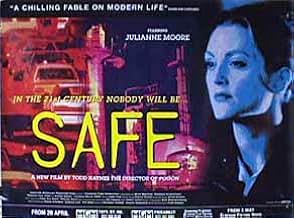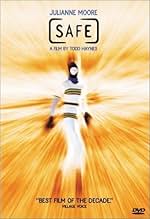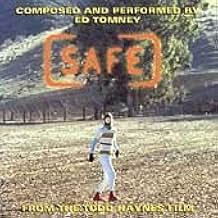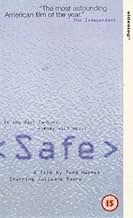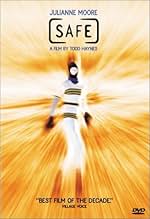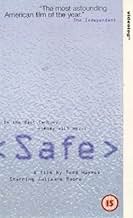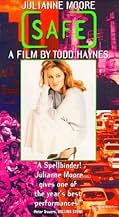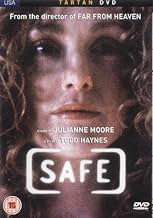VALUTAZIONE IMDb
7,1/10
18.563
LA TUA VALUTAZIONE
Una casalinga benestante e non eccezionale sviluppa una sensibilità chimica multipla.Una casalinga benestante e non eccezionale sviluppa una sensibilità chimica multipla.Una casalinga benestante e non eccezionale sviluppa una sensibilità chimica multipla.
- Regia
- Sceneggiatura
- Star
- Premi
- 4 vittorie e 13 candidature totali
Martha Velez
- Fulvia
- (as Martha Velez-Johnson)
Chauncey Leopardi
- Rory
- (as Chauncy Leopardi)
Allan Wasserman
- Client
- (as Alan Wasserman)
Jean St. James
- Client's Wife
- (as Jean Pflieger)
Recensioni in evidenza
Safe is perhaps a tad too ambiguous for its own good. The film focuses on a suburban housewife (Julianne Moore) who feels sick for no reason. Her doctor suggests psychological treatment, but she finds more comfort in the idea that her sickness is caused by environmental factors, such as car fumes and the like. Haynes never answers the question of what is really affecting Moore. One moment you're sure it's psychological, then physical symptoms displayed by the woman are undeniable. It's not that I really wanted the questions answered, but the constant toying with the audience does become a strain, especially as the film runs for two hours and not much happens. There's also the possibility that the story isn't meant to represent reality, but instead it might be allegorical. This makes it all the more difficult to unravel. I know I sound sort of negative in this review, but I did like it. I don't think it works completely, but I found it fascinating. One reason it does work at all is that Haynes' major goal seems to want to put us inside Moore's head. It shows us what it would be like to suffer and not know why, and how comfortable it might be to, say, join a cult, which is basically what she does in the end. Not entirely satisfying, but definitely well worth a look.
Todd Haynes's modern melodrama, Safe (1995), has proven to be quite a controversial film for debate amongst film critics. Those who enjoyed the film defended it as an excellent critique on the twentieth century while others claimed it to be slow and boring. Although, as the study of film progresses Safe is being viewed under a differently light and becoming more accepted amongst American movie goers, developing what looks like the beginnings of a cult following. I would side with those who agree that the film is an excellent critique of the twentieth century although that is not my focus of analysis for this commentary.
The real focus of analysis involves one extremely short scene: where Carol White comes home and stares at the new furniture after it has been brought into the house a second time, which was about half way through the film. The mise-en-scene in this short five to ten second shot is extraordinary in its capture of the mood or in Carol White's case the sickness behind suburban life.
The new couch alone was the most powerful aspect of mise-en-scene. There it was, black in color, square in shape, perfectly spaced between the walls and lamps. The couch is empty and unused yet filling in space and suburban peace of mind. It is the focus of the entire shot, forcing the audience to stare on waiting for a reaction, some kind of acknowledgment from Carol White. The couch, to me, has essentially become a reflection of Carol White, fitting since her name is just as blank and lifeless as the couch.
I also thought the lighting of the room was crucial in creating the setting for the couch. The low key lighting of the enclosed room shuts out all life, helping to create that dead environment which Carol White cannot seem to escape. The darker scene really blurs the edges of the couch and the corners of the walls, forming a cave like design. This particular aspect of light really adds to the frighteningly scary mood which is most commonly felt and scene by audience members, but never really thought about or understood.
Sound and lack of it really set the tone for hidden narratives of suburban horror. The beginning of the short scene depicts Carol White walking in the darkened room to see the new couch, and only her light footsteps are heard. After this there is complete silence for at least five to ten seconds. Since the scene did not have any muffled background sounds I found it to be quite useful in describing the silence in which Carol White lives her life. Even the furniture is louder than she.
The style of mise-en-scene in this scene is quite evident throughout the rest of the film, and really shows its importance as a tool in every cinematic genre. A film such as Safe demands attention to detail and a unique style when it comes to mise-en-scene. One should always take the time to stop and enjoy the symbols, messages, and hidden narratives behind mise-en-scene.
The real focus of analysis involves one extremely short scene: where Carol White comes home and stares at the new furniture after it has been brought into the house a second time, which was about half way through the film. The mise-en-scene in this short five to ten second shot is extraordinary in its capture of the mood or in Carol White's case the sickness behind suburban life.
The new couch alone was the most powerful aspect of mise-en-scene. There it was, black in color, square in shape, perfectly spaced between the walls and lamps. The couch is empty and unused yet filling in space and suburban peace of mind. It is the focus of the entire shot, forcing the audience to stare on waiting for a reaction, some kind of acknowledgment from Carol White. The couch, to me, has essentially become a reflection of Carol White, fitting since her name is just as blank and lifeless as the couch.
I also thought the lighting of the room was crucial in creating the setting for the couch. The low key lighting of the enclosed room shuts out all life, helping to create that dead environment which Carol White cannot seem to escape. The darker scene really blurs the edges of the couch and the corners of the walls, forming a cave like design. This particular aspect of light really adds to the frighteningly scary mood which is most commonly felt and scene by audience members, but never really thought about or understood.
Sound and lack of it really set the tone for hidden narratives of suburban horror. The beginning of the short scene depicts Carol White walking in the darkened room to see the new couch, and only her light footsteps are heard. After this there is complete silence for at least five to ten seconds. Since the scene did not have any muffled background sounds I found it to be quite useful in describing the silence in which Carol White lives her life. Even the furniture is louder than she.
The style of mise-en-scene in this scene is quite evident throughout the rest of the film, and really shows its importance as a tool in every cinematic genre. A film such as Safe demands attention to detail and a unique style when it comes to mise-en-scene. One should always take the time to stop and enjoy the symbols, messages, and hidden narratives behind mise-en-scene.
Julianne Moore is one of my favorite actresses and that's the reason I decided to watch this one.
This film is labeled as Drama/Thriller. Well, the drama's here, no doubt, as Carol White (Moore) slowly begins to succumb to the multiple effects of all types of pollution that pervade our technocratic consumer societies. There's psychological drama also as her husband, Greg (Xander Berkeley) tries to come to some understanding about Carol and how his marriage seems to be slowly disintegrating. And, there's drama also when Carol reacts violently to various chemicals, such that she is hospitalized and undergoes a battery of tests...
But... Thriller? Not at all, not by a long shot.
This is something better than mere thrills at one level, it's a modern horror story that we are all living, because we are all part of this petrochemical world that we cannot reasonably escape. At another level, it's also the horror that results when a person decides to dislocate from the polluted world we all live in and construct another world within the mind. The end result of such an act is usually madness... eventually.
Beautifully acted by all the players, so that it seems that they aren't acting; it is, after all, all too real, is it not? The musical background is simply stunning brooding, dark, menacing, and reminiscent of a David Lynch soundtrack. Visually, for the first half, you are battered with repetitive images of unending lines of traffic, excessive noise, mindless activities, rampant consumerism all designed to reflect the battered mind and body of Carol as she struggles to determine her future in a world that is increasingly threatening.
How she does that forms the second half. Does she succeed? I could say Yes and No, but I'll leave it up to you to decide when you see it. Enjoy...if you can!
This film is labeled as Drama/Thriller. Well, the drama's here, no doubt, as Carol White (Moore) slowly begins to succumb to the multiple effects of all types of pollution that pervade our technocratic consumer societies. There's psychological drama also as her husband, Greg (Xander Berkeley) tries to come to some understanding about Carol and how his marriage seems to be slowly disintegrating. And, there's drama also when Carol reacts violently to various chemicals, such that she is hospitalized and undergoes a battery of tests...
But... Thriller? Not at all, not by a long shot.
This is something better than mere thrills at one level, it's a modern horror story that we are all living, because we are all part of this petrochemical world that we cannot reasonably escape. At another level, it's also the horror that results when a person decides to dislocate from the polluted world we all live in and construct another world within the mind. The end result of such an act is usually madness... eventually.
Beautifully acted by all the players, so that it seems that they aren't acting; it is, after all, all too real, is it not? The musical background is simply stunning brooding, dark, menacing, and reminiscent of a David Lynch soundtrack. Visually, for the first half, you are battered with repetitive images of unending lines of traffic, excessive noise, mindless activities, rampant consumerism all designed to reflect the battered mind and body of Carol as she struggles to determine her future in a world that is increasingly threatening.
How she does that forms the second half. Does she succeed? I could say Yes and No, but I'll leave it up to you to decide when you see it. Enjoy...if you can!
This film is a remarkable exploration of the subtle yet terrifying ways in which everyday life can consume us. The standout performance from Julianne Moore as Carol White, a housewife who becomes increasingly allergic to her environment, serves as the perfect vessel to capture this eerie and disturbing sense of unease.
Moore's portrayal of Carol is a masterclass in understated acting. Throughout the film, she communicates a deep sense of fear and confusion through subtle physical gestures and inflections of her voice. One scene, in particular, where she breaks down in tears in her car, encapsulates the intensity of her performance.
The horror of the film, however, is not in jump scares or gore, but in the slow burn of Carol's deterioration. As her symptoms worsen, she becomes isolated from her family and friends, unable to find solace in her own home or the outside world. The mundanity of her suburban life becomes a metaphor for the very thing that's slowly destroying her.
The film's conclusion is ambiguous, leaving us uncertain as to whether Carol can ever truly escape from the grip of her isolation and illness. This open-endedness adds to the overall sense of unease, reinforcing the idea that we're constantly under threat from the everyday world around us.
Safe is a haunting film that terrifies through its quiet and understated approach. Julianne Moore's exceptional performance is central to this, but the masterful direction and cinematography make it a complete work of art. It's a must-see for anyone interested in exploring the ways in which modern life can corrode our mental and physical health.
Moore's portrayal of Carol is a masterclass in understated acting. Throughout the film, she communicates a deep sense of fear and confusion through subtle physical gestures and inflections of her voice. One scene, in particular, where she breaks down in tears in her car, encapsulates the intensity of her performance.
The horror of the film, however, is not in jump scares or gore, but in the slow burn of Carol's deterioration. As her symptoms worsen, she becomes isolated from her family and friends, unable to find solace in her own home or the outside world. The mundanity of her suburban life becomes a metaphor for the very thing that's slowly destroying her.
The film's conclusion is ambiguous, leaving us uncertain as to whether Carol can ever truly escape from the grip of her isolation and illness. This open-endedness adds to the overall sense of unease, reinforcing the idea that we're constantly under threat from the everyday world around us.
Safe is a haunting film that terrifies through its quiet and understated approach. Julianne Moore's exceptional performance is central to this, but the masterful direction and cinematography make it a complete work of art. It's a must-see for anyone interested in exploring the ways in which modern life can corrode our mental and physical health.
There are some that feel that a thriller has to be a rollercoaster ride with thrills and spills every minute. This film is not that kind of thriller. SAFE is like those chilling dreams where you are being dragged through something somewhat familiar yet otherworldly and just out of reach of total comprehension. Those sort of dreams are annoying, but we all have them anyway. Some people shrug them off, some think they can explain it away by analysis, and some just like to bask in the fact that they are mysterious, heart-palpitating, and fascinating. I'm in the latter category, and such is my love for this film. This film is like a kaleidoscope where the patterns seem fixed and definable, yet are constantly changing.
There's no doubt that Todd Haynes has something to say about the toxicity of our environment, the toxicity of our relationships, the toxicity of our generic society, and even the toxicity of our venues of healing. Doctors and psychiatrists for example, are cold and sterile and seemingly wearing blinders and cotton in their ears when it comes to really seeing or listening to their patients. New Age healers on the other hand are warm and receptive and seemingly interested in seeing you, hearing you and knowing you. But they trod down the same path that religious fundamentalists do. If your faith isn't strong enough; you won't be healed. One recollects New Age healers' like Louise Hay who claimed that AIDS victims had subliminal desires to hurt themselves, but could be cured with a strong dose of self-love. An especially nasty ruse, when one considers how most of society has already blamed the victim. AIDS victims shouldn't blame themselves, but they shouldn't believe that enough' faith will heal them either. So we can feel for Carol White (as generic sounding a name as one could imagine!) who knows her illness to be real, but who feels guilty nonetheless because no one will let her own her illness. They don't even know she exists, really. And she, from the beginning of this film, isn't sure either.
Carol is an enigma to herself. She's like a fish in an aquarium (her house in fact, looks sort of like a dungeon set in a space-age aquarium), only she never really saw her life as such until she reached the pinnacle of success defined by society. At the opening of the film, she's got it all': wealth, security, servants, friends', family' and health (well, for the time being). But what happens when you've reached the pinnacle of success? Just be happy going to dull social functions and decorate your proverbial palace? Carol begins to see her life her aquarium- from outside. It's dull, blue and facile. A person who has a sense of self could try to survive in the ocean' of life, but Carol isn't such a person. So it's not so unnatural that she might become so vilely inebriated by the blandness and inanity of her life that she can barely talk and ultimately, can barely breathe. One can get literally ill with an overdose of generic, stupefying life. Ever been stuck in a dentist's waiting room listening to the likes of Tony Orlando and Dawn or Linda Ronstadt? We're talking real nausea here! So imagine being a person who lives in a 24/7 world of pastel colours, pop musak, shopping, vacuous conversation with friends', and being married to a man who has less charisma than a houseplant. Depression of that magnitude would leave any person raw. Carol's blues (which we can see literally in the lighting of her house and in the God-awful furniture) have broken her. Once she realized how raw she'd become, she lost all sense emotionally and physically- in how to cope. Perhaps the reason that no one could help her was that they were all too busy enjoying the decor of their proverbial aquariums. Her husband, her friends, her doctors, even the new Age healers, LIKE the limited, appropriately fashioned, seemingly inoffensive world they've found their niche in. Gosh knows, I've thought myself nuts for not being part of the majority of the population that likes shopping malls, industrial architecture, Nike, Julia Roberts, or franchise coffee houses' that serve their overpriced coffee in paper cups. I kind of understand why Carol would want to bury herself in an igloo by the end of the film. But New-Agey as it may be, there is a glimmer of hope when she stands at the mirror and chokes out `I love you' to her reflection. It's not exactly Descartes' `I think, therefore I am', but its affirmation enough that she does indeed have a face and a heart. She does indeed exist. I think that's what Todd Haynes' message to us is. SAFE is a cry for us to take a good, hard look at the world around us, to recognize its variety of poisons, and to make a stand to save it and to save ourselves.
There's no doubt that Todd Haynes has something to say about the toxicity of our environment, the toxicity of our relationships, the toxicity of our generic society, and even the toxicity of our venues of healing. Doctors and psychiatrists for example, are cold and sterile and seemingly wearing blinders and cotton in their ears when it comes to really seeing or listening to their patients. New Age healers on the other hand are warm and receptive and seemingly interested in seeing you, hearing you and knowing you. But they trod down the same path that religious fundamentalists do. If your faith isn't strong enough; you won't be healed. One recollects New Age healers' like Louise Hay who claimed that AIDS victims had subliminal desires to hurt themselves, but could be cured with a strong dose of self-love. An especially nasty ruse, when one considers how most of society has already blamed the victim. AIDS victims shouldn't blame themselves, but they shouldn't believe that enough' faith will heal them either. So we can feel for Carol White (as generic sounding a name as one could imagine!) who knows her illness to be real, but who feels guilty nonetheless because no one will let her own her illness. They don't even know she exists, really. And she, from the beginning of this film, isn't sure either.
Carol is an enigma to herself. She's like a fish in an aquarium (her house in fact, looks sort of like a dungeon set in a space-age aquarium), only she never really saw her life as such until she reached the pinnacle of success defined by society. At the opening of the film, she's got it all': wealth, security, servants, friends', family' and health (well, for the time being). But what happens when you've reached the pinnacle of success? Just be happy going to dull social functions and decorate your proverbial palace? Carol begins to see her life her aquarium- from outside. It's dull, blue and facile. A person who has a sense of self could try to survive in the ocean' of life, but Carol isn't such a person. So it's not so unnatural that she might become so vilely inebriated by the blandness and inanity of her life that she can barely talk and ultimately, can barely breathe. One can get literally ill with an overdose of generic, stupefying life. Ever been stuck in a dentist's waiting room listening to the likes of Tony Orlando and Dawn or Linda Ronstadt? We're talking real nausea here! So imagine being a person who lives in a 24/7 world of pastel colours, pop musak, shopping, vacuous conversation with friends', and being married to a man who has less charisma than a houseplant. Depression of that magnitude would leave any person raw. Carol's blues (which we can see literally in the lighting of her house and in the God-awful furniture) have broken her. Once she realized how raw she'd become, she lost all sense emotionally and physically- in how to cope. Perhaps the reason that no one could help her was that they were all too busy enjoying the decor of their proverbial aquariums. Her husband, her friends, her doctors, even the new Age healers, LIKE the limited, appropriately fashioned, seemingly inoffensive world they've found their niche in. Gosh knows, I've thought myself nuts for not being part of the majority of the population that likes shopping malls, industrial architecture, Nike, Julia Roberts, or franchise coffee houses' that serve their overpriced coffee in paper cups. I kind of understand why Carol would want to bury herself in an igloo by the end of the film. But New-Agey as it may be, there is a glimmer of hope when she stands at the mirror and chokes out `I love you' to her reflection. It's not exactly Descartes' `I think, therefore I am', but its affirmation enough that she does indeed have a face and a heart. She does indeed exist. I think that's what Todd Haynes' message to us is. SAFE is a cry for us to take a good, hard look at the world around us, to recognize its variety of poisons, and to make a stand to save it and to save ourselves.
Lo sapevi?
- QuizWhen it came time for Julianne Moore to record the director's commentary for the 2003 DVD release, this was the first time the lead actress had seen the movie in its entirety.
- BlooperAlthough this film was explicitly set in 1987, while Carol is driving on the highway, she passes a burgundy 1992 Cadillac de Ville.
- Citazioni
Carol White: [about her declining health] I'm sorry. I know it's not normal but I can't help it.
I più visti
Accedi per valutare e creare un elenco di titoli salvati per ottenere consigli personalizzati
- How long is Safe?Powered by Alexa
Dettagli
- Data di uscita
- Paesi di origine
- Lingue
- Celebre anche come
- A salvo
- Luoghi delle riprese
- Aziende produttrici
- Vedi altri crediti dell’azienda su IMDbPro
Botteghino
- Budget
- 1.000.000 USD (previsto)
- Lordo Stati Uniti e Canada
- 512.245 USD
- Fine settimana di apertura Stati Uniti e Canada
- 15.830 USD
- 25 giu 1995
- Lordo in tutto il mondo
- 512.558 USD
Contribuisci a questa pagina
Suggerisci una modifica o aggiungi i contenuti mancanti



